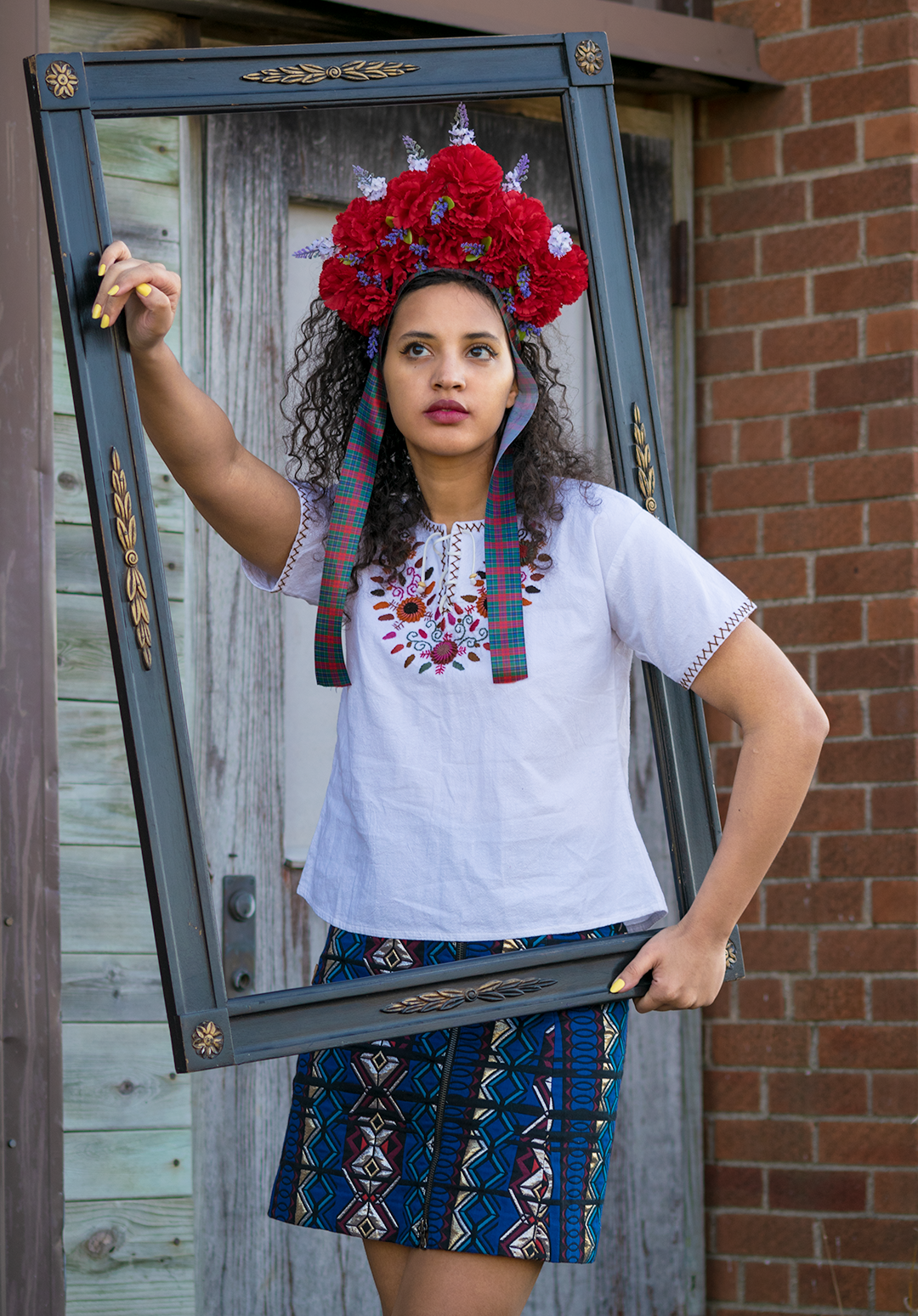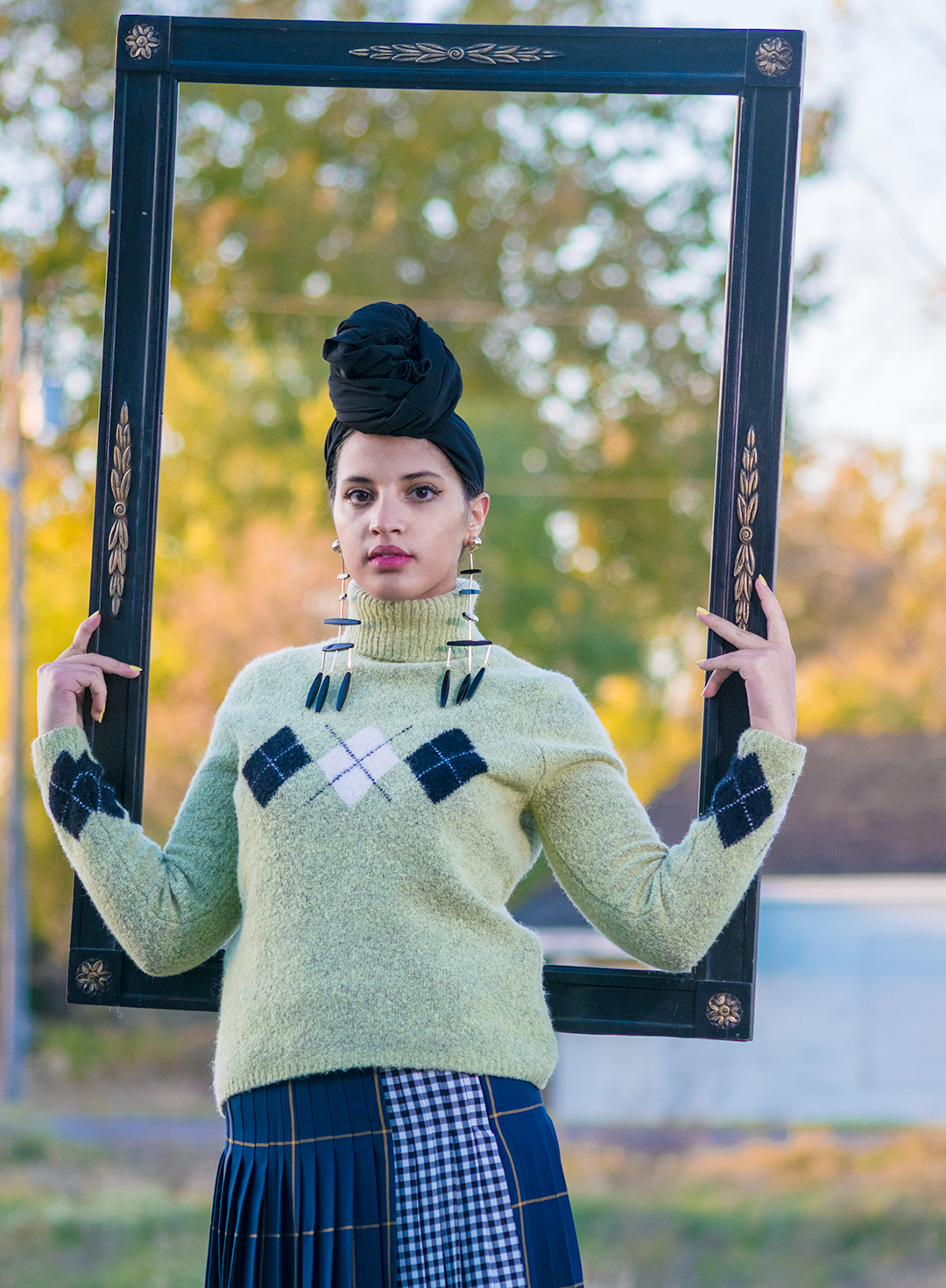Identity Series: Part 2 Identity Expression through Fashion
To see all the fashion associated with this editorial, check out our look book below.
Read part 1 of our Identity series here (History of Czech Kolache + Recipes) and part 3 here (Hidden Traits of the INTJ Female).
“What are you?”
As a racially ambiguous person, this is by far one of the most common questions I hear. While it is tempting to remind the asker that I am human just like them, I’ve never minded the question all that much, as I am proud of who I am, and curious about how other people identify as well. There are many things that make us who we are from ethnic identity, taste in music, favorite foods, or even MBTI types. However, these initial identity expressions might be shallow compared to deeper cultural factors such as socio-economic status, the geographic location of where you grew up, cultural affiliations, and life experiences. Needless to say, identity is complicated. For the sake of fashion, however, this editorial features looks that express my unique mix of ethnic identities while also discussing what identity is and how we use fashion to express ourselves from an ethnic perspective.

What is identity?
Identity can be a hard thing to track down, as explained in “Identity as a Variable”, “The wide variety of conceptualizations and definitions of identity have led some to conclude that identity is so elusive, slippery, and amorphous that it will never prove to be a useful variable for the social sciences.” Indeed, identity on its own encompasses too many aspects to easily be a useful measure in sociological studies where rigorous analysis is applied, but from a broader perspective, identity might be defined as the many pieces that make you who you are. Louis Cozolino explains in his book The Neuroscience of Human Relationships, that the human consciousness views itself as an individual, as an isolated self, even as we are equally influenced by outside sources and social units. And so, we have self-identity, how we define ourselves, and social identity, which encompasses how we relate, influence, and interact with each other.
The identity we’re discussing is self-identity, but just how do we decide what makes us who we are? Developmental psychologist James Marcia built upon Erik Ekrikson’s theory on identity development to say that children enter four distinct statuses as they move from identity crisis and identity achievement. These four statuses are: diffusion, foreclosure, moratorium, and achievement (David). Within the diffusion status, children don’t have much choice or identity, but as they move into foreclosure, they begin to take on roles and commit to goals and values. As children enter the moratorium status, they have an identity crisis and explore different identities but don’t commit to them. Finally, when the achievement status has been reached an identity has been committed too. This process is not linear and is based on specific traits, for example, values and goals, sexual orientations, or for the millennials, to avocado toast or not. The formation of a specific identity trait is based on the choices made by the individual and how committed they are to those choices. That means that people can have weak or strong identities and that each identity is its own entity. People who have a low sense of self have difficulty defining what they are good or bad at, compared to someone who has a strong sense of self (David). Overall, as children develop they accumulate more and more identities which come together to form a whole person.
While this theory was created with adolescence in mind, I think that this model can be applied to anyone. Identity, after all, isn’t static. We play many roles over our lives, we grow, we change, we regress. Who we find ourselves to be today isn’t who we were yesterday, nor who we will be tomorrow. So, stay in the crisis, learn and grow, renew. It’s human nature to change.

Identity Expression Through Fashion
As a vehicle of identity expression, fashion gives us a unique perspective because it harnesses both the expression of the individual and society. Moreover, how you dress personally, may affect how you are accepted and perceived within a social group. Fashion is itself, a social system and through this systematic influence, identifying markers, such as social class, gender, and ethnicity are a part of one’s outward persona as an expression of cultural and social identity. Ethnic identity, however, does not necessarily imply cultural identity. With globalization, traditionally ethnic fashion styles have gone mainstream. Today, people wear and express themselves with clothing not representative of their biological ethnic makeup, a kind of intercultural dress, every day. This may be called appropriation, however, it’s much more complicated. This mish mash of intercultural fashion has been an expression of affiliations and identity for centuries with origins in luxury.
Often the study of fashion is from the perspective that that modern fashion emanated from the West as the center of the fashion discourse, while ethnic clothing is on the periphery, representing tradition and stability (Skov, 2010). However, there has always been a fascination with peripheral ethnic dress. On one hand its traditional and stable and on the other it’s exciting and exotic. Indeed, this exploration of elsewhere is how ethnic dress began to spread as a form of luxury. In terms of Western consumption of foreign luxury goods, trade brought in all manner of luxuries like silk, cashmere, spices and other foodstuff from Persia, Egypt, and Central Asia, and later India, China, Japan, Colombia, and Mexico (Trade Routes between Europe and Asia during Antiquity).
What started as a demand for the exotic soon morphed into new industries as designs and production methods were imitated. This can be seen in Italian and French silk production, which was originally a Chinese export (Skov, 2010). Cashmere, another example of this multicultural connection was originally an Indian export. Today it has become synonymous with Western ideas of luxury and has lost some of the original cultural significance as a necessary fashion for the cold northern Kashmir region the wool came from (The history and origins of cashmere).
Modern Ethnic dress
In more modern times, ethnic style has played an important role as a form of experimentation for designers. In the early 1900’s Paul Poiret modified the silhouette of the Japanese kimono to incorporate into dresses, and later, he took inspiration from Middle Eastern sultan-and-harem styles. Mariano Fortuny took inspiration from contemporary Middle Eastern clothing and the Italian renaissance artistic era, to create pleated dresses.
Ethnic fashion trends have continued to capture the fashion world’s attention in a cyclical pattern. In the 1960’s Yves Saint Laurent, Kenzo, and Sonia Rykiel all showed ethnic fashions on the runways. During this time, ethnic style was “associated with transcendence of conventions, thereby allowing perceived deeper sensual qualities to be expressed”. Further, In the 1960s and 1970s, ethnic style was popular even if it wasn’t designed in the fashion world and instead purchased in import stores. Palestinian scarves, Latin American skirts, Indonesian batik sarongs, Moroccan djellabas, Chinese jackets, rattan baskets, embroidered purses, leather sandals, and tribal jewelry were worn in combination with ordinary clothes and became a highly personal as well as cosmopolitan way of dressing, even taking on a political attitude.
Today, the West continues to consume ethnic fashion, but this commoditization of ethnic fashion has made some designers feel as though they must self-exoticize to express their ethnicity. Designers who are not of that ethnicity often play with the subject in a superficial manner. For designers who chose to use their ethnicity as a form of cultural expression, constancy is key, for example Chinese designer Vivienne Tam who lives in the U.S. uses Chinese motifs in her designs consistently, so that the aesthetic incorporates cultural tradition rather than recreation. In nonwestern cultures, ethnic fashion is liked for similar reasons. Japanese consumers were found to like American fashion because it represented “unique fashion styles rare in the Japanese fashion market” among other reasons (Lee, 2017). This is very similar to the western reasons for being drawn to ethnic fashion as something new and exciting. However, commonly Western clothing is viewed as representing “entry into a wider world of trade, commerce, and international communication” where ethnically Asian clothing represented “a traditional past and continued separation from the wider Western world” (Tidwell, 2010).
Consequences of Commercialization
While we are drawn to the exotic and new, especially in terms of ethnic dress, the commercialization of ethnic dress can be harmful to the people who originated the traditions and can also have serious legal ramifications. For example, in 2012, Louis Vuitton was one of many brands to sport designs reminiscent of the African Maasai Tribe. The Maasai tribe’s cultural prints are copied so often that if it were a brand, it would be worth $10 million annually (Reed). Yet, the people of the Maasai Tribe don’t benefit from these copies, and 80% of Maasai currently live below the poverty line (Reed). Similarly, in 2015, Isabel Marant was accused of stealing embroidery designs from the Mixe community of Oaxaca, Mexico and more recently, in 2018, Gucci’s fall runway show saw white models in turbans resembling those worn within the Sikh community. Far from being cultural missteps made by a few brands, many would argue that cultural appropriation in fashion is a major crisis facing the industry. From Victoria Secret’s use of Indian headdresses in their 2017 runway show, to London fashion label KTZ copying Canadian Inuit designs for their 2015 collection, and most recently, Carolina Herrera being accused of appropriating Mexican designs for their 2020 resort wear collection, plenty of brands have had run-ins with cultural appropriation.
For fashion brands using cultural symbolism, there is a fine line between cultural appropriation and cultural appreciation. Cultural appropriation can be a hurtful side affect of fashion’s need to be new and exciting season after season. The Oxford dictionary defines cultural appropriation as “the unacknowledged or inappropriate adoption of the customs, practices, ideas, etc. of one people or society by members of another and typically more dominant people or society” (Soto). Cultural appropriation is a sociological concept and is often seen in society through a dominant culture’s exoticization of a minority culture’s symbolic elements into fashion and other products (Christmann, Rosslee). Cultural appropriation may be seen as a form of bullying or even a form of ethnocide in which a culture is pushed to extinction through its assimilation into another culture, often the dominant one, which today many consider to be Western culture.
It is however, difficult to protect cultural symbols. While cultural prints and handicraft techniques are arguably forms of intellectual property, the World Intellectual Property Organization (WIPO) does not currently protect these forms of cultural property from infringement. Because of this, there have been many instances of brands misusing cultural symbols and/or commercializing these cultural properties with no compensation to the cultures that inspired the designs. The issue becomes more complicated since many traditional symbols are no longer considered original, as they have been passed down from generation to generation and are therefore considered public domain. Additionally, to copyright cultural symbols and motifs risks significantly restricting the creative freedom of fashion brands. In the current climate where cultural appropriation has become more politicized and is largely self-policed through public outcry, ethnic dress has become a hot topic in recent years.

Reclaiming Identity
Today, intercultural fashion continues to be an expression of identities that reflect a globalized world, but the commercialization of ethnic dress may have caused many of us to become blind to the deeper cultural heritage our fashion represents, whether that heritage is our own or that of another. Through this fashion editorial, I have purposefully used obvious representations of my cultural heritage to play with ethnic dress and identity expression. My outfits are a mix of Czech, Scottish, British, and African American ethnic fashions, though this does not represent the many cultural identities I have as a multi-ethnic woman, nor the many other identities with which I identify. Through research for this editorial, I was able to learn more about the ethnic dress of my ancestors and become more aware of the complex role fashion plays in identity. For example, the flower crown featured in one of our looks is styled based on a traditional Czech crown, a cultural piece that was often worn for weddings or celebrations. Flower crowns have historically been worn by many cultures in Eastern Europe, as well as China, but now days many people wear flower crowns as part of Bohemian style without understanding the cultural history. The ribbon attached to the crown has the Scottish McLean family tartan. It is considered poor taste to wear a tartan that is not your clan, and it is illegal to take a family tartan and mass produce it for fashion. In most of the pictures, I wear headscarves to represent African ancestry, but African headdress is very diverse and can depend on the region you are from, whether it be a Nigerian Gele, a Congolese Kuba hat, or other types of head gear.
Overall, fashion offers us a chance to explore who we are and represent ourselves to the world. It is a unique mix of the time and society in which we live, as well as a personal expression of self. As our world becomes increasingly global, and our identities all the more complex, the fashions we wear may evolve to become hyper-personalized. Through technologies like 3d printing, spray on fabric, and digital/AI fashion, fashion can truly come to represent a form of self-expression that is both genuine and unique to each of us as individuals.
Don’t forget to check out part 1 of our Identity series (History of Czech Kolache + Recipes) and part 3 (Hidden Traits of the INTJ Female).
References:
Abdelal, Rawi, Yoshiko M. Herrera, Alastair Iain Johnston, and Rose McDermott. “Identity as a Variable.” Harvard Business School. December 2006 | Vol. 4/No. 4.
Cozolin, Louis. “The Neuroscience of Human Relationships.” W.W. Norton Company. New York.
David L, “Identity Status Theory (Marcia),” in Learning Theories, July 23, 2014, https://www.learning-theories.com/identity-status-theory-marcia.html
Skov, Lise. “Ethnic Style in Fashion.” In The Berg Companion to Fashion, edited by Valerie Steele. Oxford: Bloomsbury Academic, 2010. https://0-www.bloomsburyfashioncentral.com.library.scad.edu/products/berg-fashion-library/encyclopedia/the-berg-companion-to-fashion/ethnic-style-in-fashion.
Tidwell, Christy. “Street and Youth Fashion in Japan.” In Berg Encyclopedia of World Dress and Fashion: East Asia, edited by John E. Vollmer, 398–403. Oxford: Berg Publishers, 2010. http://0-dx.doi.org.library.scad.edu/10.2752/BEWDF/EDch6063.
“The history and origins of cashmere.” One Cashemere. https://www.onecashmere.com/en/history-cashmere/
Lee, Juyoung, and Jihyeong Son. “Exploring Japanese consumers’ cultural meanings and consumption of American fashion.” The International Review of Retail, Distribution and Consumer Research. Volume 27 Issue 2. Pages 207-223. Mar 2017. https://0-www.tandfonline.com.library.scad.edu/doi/full/10.1080/09593969.2017.1288649?scroll=top&needAccess=true
“Trade Routes between Europe and Asia during Antiquity.” Met Museum. https://www.metmuseum.org/toah/hd/trade/hd_trade.htm
Thomas, Dana. Deluxe: How Luxury Lost Its Luster. Penguin. 2007. https://books.google.com/books?id=U2OXVwzVAfIC&pg=PA80&lpg=PA80&dq=chanel+in+japan+1980s&source=bl&ots=XZoMxYhlJi&sig=vvvnxMCEJBwVEWHR1cm5KSlkVcc&hl=en&sa=X&ved=0ahUKEwiwgKOWporNAhWJSCYKHf5-BUgQ6AEIMTAD#v=onepage&q=chanel%20in%20japan%201980s&f=false
“Dries van Noten Biography.” Dries van Noten. https://www.driesvannoten.be/biography/.
“Revealing of cocoons China.” Sonia Holiday Photo Library. http://www.soniahalliday.com/category-view3.php?pri=232-3-73.jpg
Farre, Nuria. “Mariano Fortuny, the Leonardo da Vinci of the twentieth century in the Hermitage in St. Petersburg.” Magazine Horse.January 25, 2017. http://www.magazinehorse.com/en/mariano-fortuny-the-leonardo-da-vinci-of-the-twentieth-century-in-the-hermitage-in-st-petersburg/
Natasha, Reed. “Cultural and Intellectual Property Appropriation: Disputes Over Culturally-Inspired Fashions.” Trademark and Copyright Law Foley and Hoag LLP. February 8, 2019. https://www.trademarkandcopyrightlawblog.com/2019/02/cultural-and-intellectual-property-appropriation-disputes-over-culturally-inspired-fashions/
Judith Soto. “Hands Off My Heritage: Cultural Appropriation And Trademarks.” Trademark Now. March 6, 2019. https://www.trademarknow.com/blog/hands-off-my-heritage-cultural-appropriation-and-trademarks
Myriam Christmann, Nic Rosslee. “The Thorny Issue of Cultural Appropriation.” Adams & Adams. 2018. https://adamsadamsip.com/the-thorny-issue/
